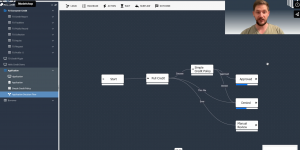I’m fascinated with developments in codeless platforms and Large Language Models (LLMs) as they make inroads towards replacing traditional coding. These innovations have been evolving for decades, but as they converge, the role of software will be forever altered.
Codeless platforms are not new
The term codeless or no-code has entered a new hype cycle in recent years, but the concept is far from new. WordPress, which I’m using to create this blog, is a great example of a codeless website builder. Salesforce has been leading the no-code CRM revolution for decades and AWS is a great practical application of a codeless solution for IT management. Each of these solutions have enabled less technical resources to build working software solutions much more quickly than traditional coding techniques.
As it becomes easier to turn intention directly into working software, the role of developer as an intermediary between creatives and their solutions will disappear as completely as scribes and typists have disappeared from the creation of documents. The ability to turn ideas into working business solutions is now becoming as simple as writing a document or building a spreadsheet. As that happens, being able to ‘code’ will be similar to being able to write English – most people will be able to do some form of it, but what will be most important is what you have to say.
The part that I find most fascinating are what I consider near-term misconceptions in how codeless will evolve. Codeless advocates are advertising the ability to create software solutions with zero language or syntax. I believe that is naïve – building a complex solution with no language interface would be like trying to write a legal brief with emojis. There is too much nuance in how you expect your unique solution to behave for someone to create a GUI that fully anticipates your needs. Language and syntax are what makes humans unique in our ability to conceive of and communicate an unlimited spectrum of ideas, and I believe language, whether based on expressions or prose, whether written or spoken, must be a critical part of any future autonomous software solutions.
LLMs make codeless much more interesting
That is where large language models (LLMs) come it. While deep learning has been around for decades, recent breakthroughs bring us much closer to bridging the gap between knowledge, data, and natural language syntax. That is exciting. These developments are what will allow us to mature the vision of codeless software for more mainstream use. There will still be syntax required to fully articulate a solution, but very soon that syntax will be more efficient, more natural and easier to access by non-technologists.
The current state of LLMs being used to write code are a bit naïve. Our current coding frameworks are entirely too repetitive and pedantic. Code scaffolding has to be created across multiple levels of architecture to create even simple working software and we have employed legions of coders to create and re-create that scaffolding. Early LLM code generation examples show how software can be accelerated by allowing AI to gather scaffolding examples and rework them into working code. Impressive, but largely unnecessary. Codeless solutions are making that redundant scaffolding unnecessary by providing a higher level of tools to turn ideas directly into working software.
The magic happens when you leverage LLMs on top of codeless platforms.
What becomes very interesting will be solutions that layer LLMs on top of codeless platforms. As described above, point and click is not enough to create complex software solutions, but using traditional logic syntax is not accessible to non-technologists. LLMs can resolve that, by translating natural language syntax into directives that can be implemented in codeless frameworks.
AWS – A practical example
As an example, think about AWS and how they’ve used codeless (including syntax, a.k.a. chef recipes) to accelerate the building and maintenance of IT systems. This is powerful in itself, but while you can point and click together basic IT components, serious users of the platform need to understand simple scripting grammar and syntax to automate and scale their solutions. Adding LLM builders on top of that tool set will be tremendously powerful, allowing less technical staff to create their IT infrastructure with natural language commands (just like Star Trek). By comparison, asking LLMs to directly construct raw datacenters from the ground up would be a disaster, you would end up with an unmaintainable mash-up of scripts and configuration files. True synergy is bringing codeless and LLMs together.
This synergy will soon be coming to all businesses. The intersection between advances in codeless frameworks and LLMs is where true AI is happening and it is poised to change software forever.





Comments are closed.